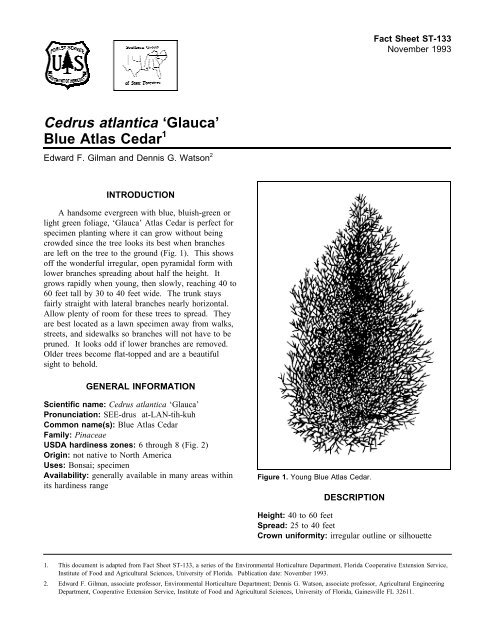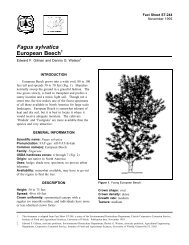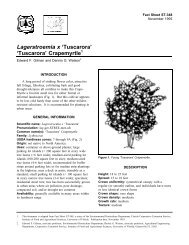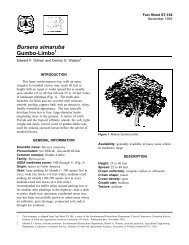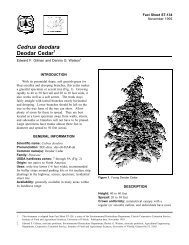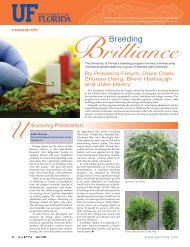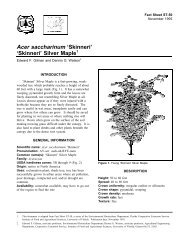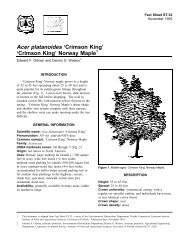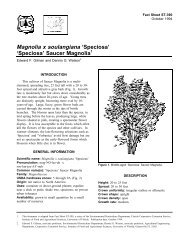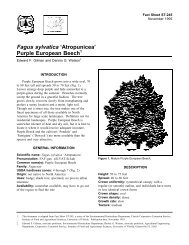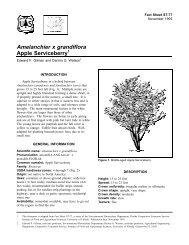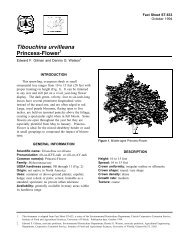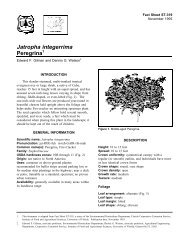Cedrus atlantica 'Glauca' Blue Atlas Cedar - Environmental ...
Cedrus atlantica 'Glauca' Blue Atlas Cedar - Environmental ...
Cedrus atlantica 'Glauca' Blue Atlas Cedar - Environmental ...
Create successful ePaper yourself
Turn your PDF publications into a flip-book with our unique Google optimized e-Paper software.
<strong>Cedrus</strong> <strong>atlantica</strong> ‘Glauca’<br />
<strong>Blue</strong> <strong>Atlas</strong> <strong>Cedar</strong> 1<br />
Edward F. Gilman and Dennis G. Watson 2<br />
INTRODUCTION<br />
A handsome evergreen with blue, bluish-green or<br />
light green foliage, ‘Glauca’ <strong>Atlas</strong> <strong>Cedar</strong> is perfect for<br />
specimen planting where it can grow without being<br />
crowded since the tree looks its best when branches<br />
are left on the tree to the ground (Fig. 1). This shows<br />
off the wonderful irregular, open pyramidal form with<br />
lower branches spreading about half the height. It<br />
grows rapidly when young, then slowly, reaching 40 to<br />
60 feet tall by 30 to 40 feet wide. The trunk stays<br />
fairly straight with lateral branches nearly horizontal.<br />
Allow plenty of room for these trees to spread. They<br />
are best located as a lawn specimen away from walks,<br />
streets, and sidewalks so branches will not have to be<br />
pruned. It looks odd if lower branches are removed.<br />
Older trees become flat-topped and are a beautiful<br />
sight to behold.<br />
GENERAL INFORMATION<br />
Scientific name: <strong>Cedrus</strong> <strong>atlantica</strong> ‘Glauca’<br />
Pronunciation: SEE-drus at-LAN-tih-kuh<br />
Common name(s): <strong>Blue</strong> <strong>Atlas</strong> <strong>Cedar</strong><br />
Family: Pinaceae<br />
USDA hardiness zones: 6 through 8 (Fig. 2)<br />
Origin: not native to North America<br />
Uses: Bonsai; specimen<br />
Availability: generally available in many areas within<br />
its hardiness range<br />
Figure 1. Young <strong>Blue</strong> <strong>Atlas</strong> <strong>Cedar</strong>.<br />
DESCRIPTION<br />
Fact Sheet ST-133<br />
November 1993<br />
Height: 40 to 60 feet<br />
Spread: 25 to 40 feet<br />
Crown uniformity: irregular outline or silhouette<br />
1. This document is adapted from Fact Sheet ST-133, a series of the <strong>Environmental</strong> Horticulture Department, Florida Cooperative Extension Service,<br />
Institute of Food and Agricultural Sciences, University of Florida. Publication date: November 1993.<br />
2. Edward F. Gilman, associate professor, <strong>Environmental</strong> Horticulture Department; Dennis G. Watson, associate professor, Agricultural Engineering<br />
Department, Cooperative Extension Service, Institute of Food and Agricultural Sciences, University of Florida, Gainesville FL 32611.
<strong>Cedrus</strong> <strong>atlantica</strong> ‘Glauca’ -- <strong>Blue</strong> <strong>Atlas</strong> <strong>Cedar</strong> Page 2<br />
Figure 2. Shaded area represents potential planting range.<br />
Crown shape: pyramidal<br />
Crown density: moderate<br />
Growth rate: medium<br />
Texture: fine<br />
Foliage<br />
Leaf arrangement: spiral (Fig. 3)<br />
Leaf type: simple<br />
Leaf margin: entire<br />
Leaf shape: needle-like (filiform)<br />
Leaf venation: parallel<br />
Leaf type and persistence: evergreen; needle leaf<br />
evergreen<br />
Leaf blade length: less than 2 inches<br />
Leaf color: blue or blue-green<br />
Fall color: no fall color change<br />
Fall characteristic: not showy<br />
Flower<br />
Flower characteristics: inconspicuous and not<br />
showy; spring flowering<br />
Fruit<br />
Fruit shape: oval<br />
Fruit length: 3 to 6 inches<br />
Fruit covering: dry or hard<br />
Fruit color: brown<br />
Fruit characteristics: does not attract wildlife;<br />
inconspicuous and not showy; no significant litter<br />
problem<br />
Trunk and Branches<br />
Trunk/bark/branches: droop as the tree grows, and<br />
will require pruning for vehicular or pedestrian<br />
clearance beneath the canopy; not particularly showy;<br />
should be grown with a single leader; no thorns<br />
Pruning requirement: needs little pruning to develop<br />
a strong structure<br />
Breakage: resistant<br />
Current year twig color: brown; green<br />
Current year twig thickness: medium
<strong>Cedrus</strong> <strong>atlantica</strong> ‘Glauca’ -- <strong>Blue</strong> <strong>Atlas</strong> <strong>Cedar</strong> Page 3<br />
Figure 3. Foliage of <strong>Blue</strong> <strong>Atlas</strong> <strong>Cedar</strong>.<br />
Culture<br />
Light requirement: tree grows in part shade/part sun;<br />
tree grows in full sun<br />
Soil tolerances: clay; loam; sand; slightly alkaline;<br />
acidic; well-drained<br />
Drought tolerance: high<br />
Aerosol salt tolerance: moderate<br />
Other<br />
Roots: surface roots are usually not a problem<br />
Winter interest: no special winter interest<br />
Outstanding tree: tree has outstanding ornamental<br />
features and could be planted more<br />
Invasive potential: little, if any, potential at this time<br />
Verticillium wilt susceptibility: not known to be<br />
susceptible<br />
Pest resistance: no pests are normally seen on the<br />
tree<br />
USE AND MANAGEMENT<br />
Difficult to transplant, ‘Glauca’ <strong>Atlas</strong> <strong>Cedar</strong><br />
should be planted from a container. Soil preference is<br />
for well-drained deep loam, on the acid side, but it can<br />
tolerate sandy or clay soils and alkaline soil if they are<br />
very well-drained. The tree looks its best when<br />
sheltered from strong winds but tolerates open<br />
conditions, and will grow in full sun or partial shade.<br />
Allow for plenty of soil space around the tree since<br />
growth will be poor in restricted soil space. Tolerates<br />
extensive drought only when grown in an area where<br />
roots can explore a large soil area. Performs well in<br />
all areas within its hardiness range. It may be suited<br />
for zone 9 in California and Florida.<br />
Propagation is by seed.<br />
‘Pendula’ has a very strong weeping habit but<br />
must be staked and trained to make a tree, 15 feet tall;<br />
‘Argentea’ has silver, almost white foliage.<br />
Pests and Diseases<br />
No pests or diseases are of major concern.<br />
Generally free of insect pests and resistant to diseases,<br />
they may occasionally fall prey to tip blight, root rots<br />
(in poorly-drained soil) or black scale and the Deodar<br />
weevil. Usually no pest protection or control is<br />
necessary.<br />
Sap-suckers are attracted to the trunk and often<br />
riddle it with small holes. This usually does little<br />
lasting harm to the tree.


